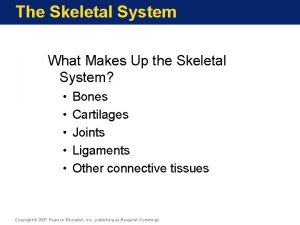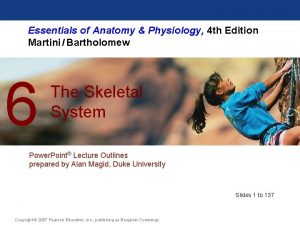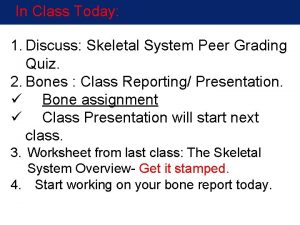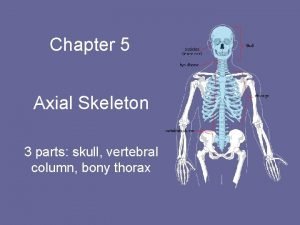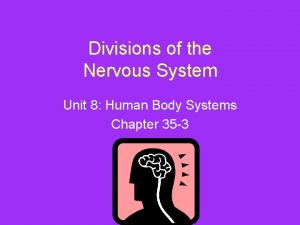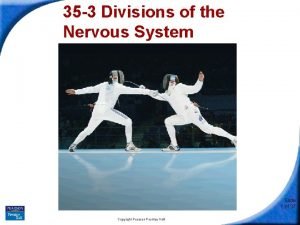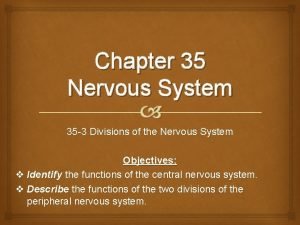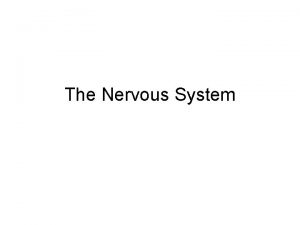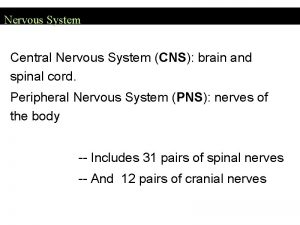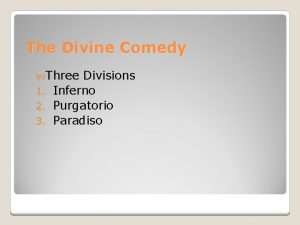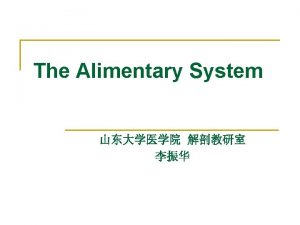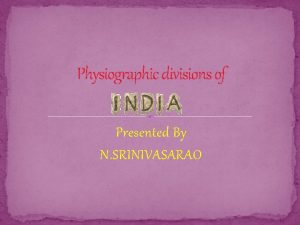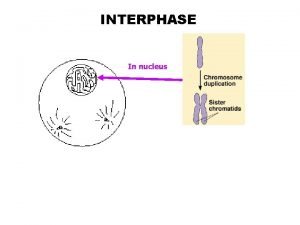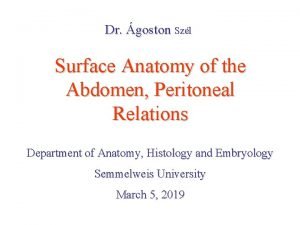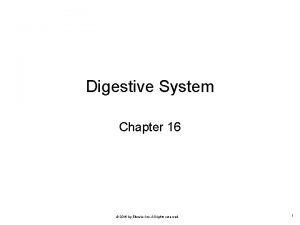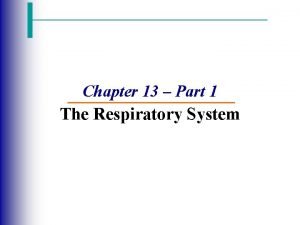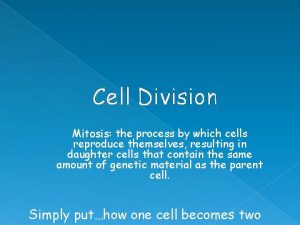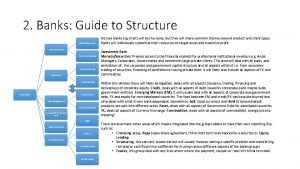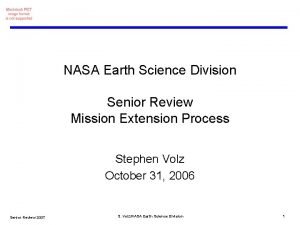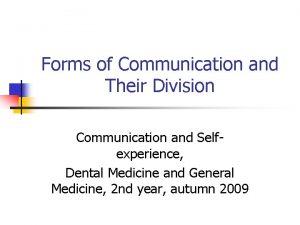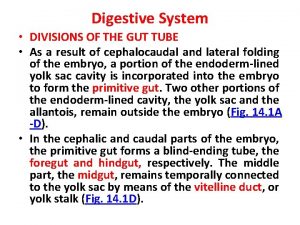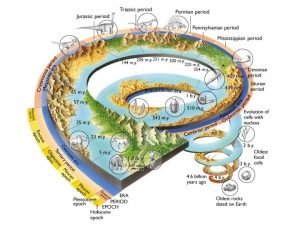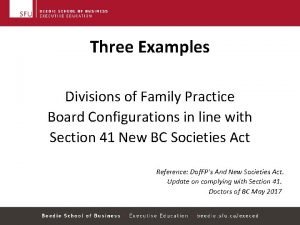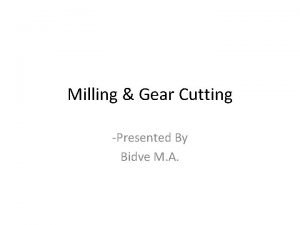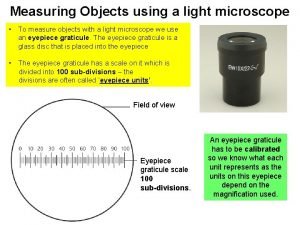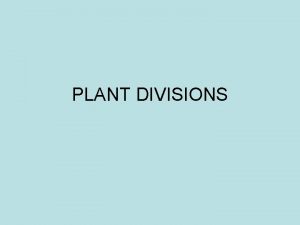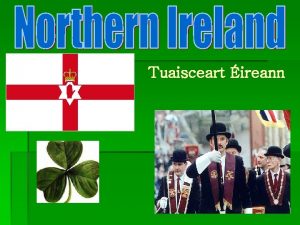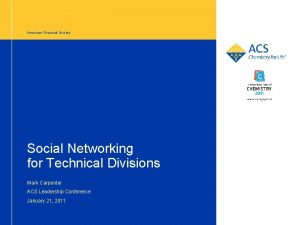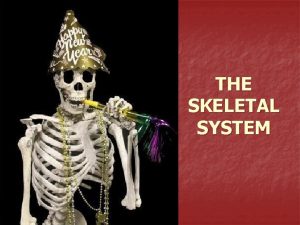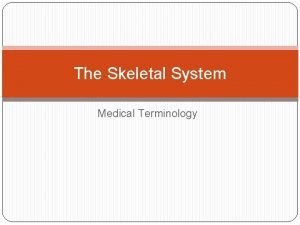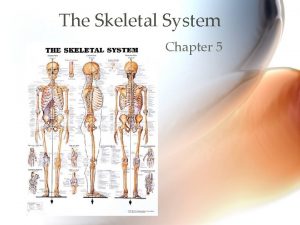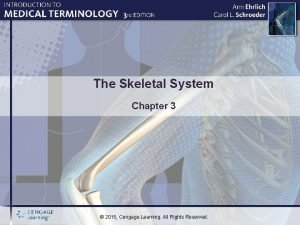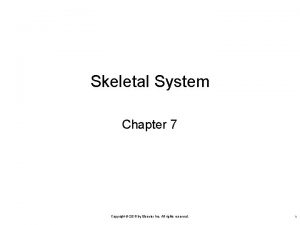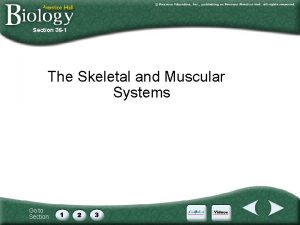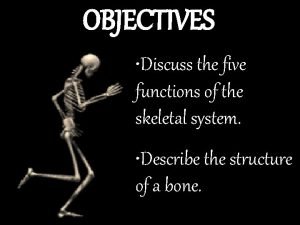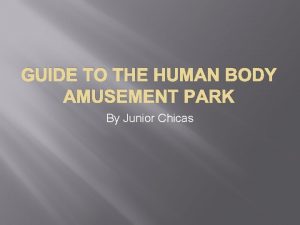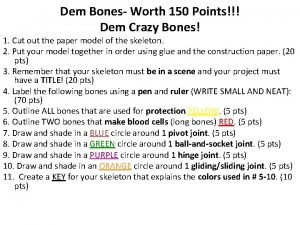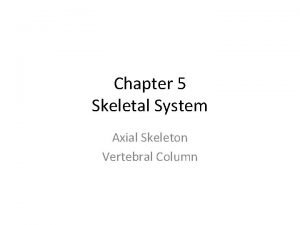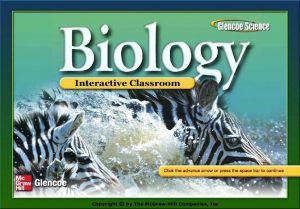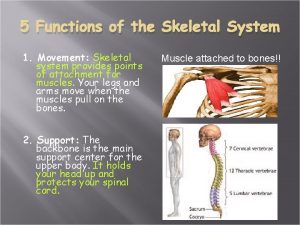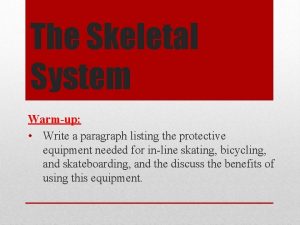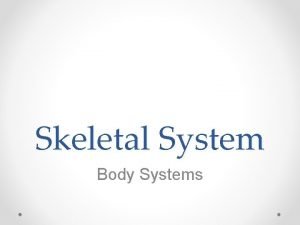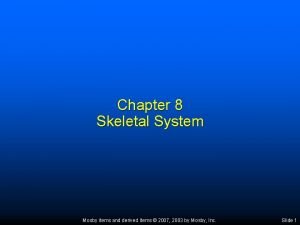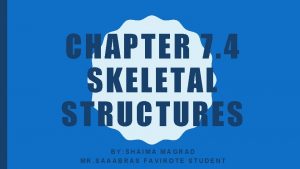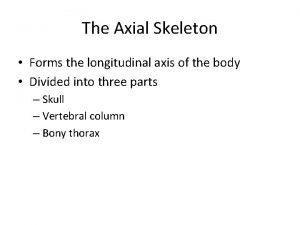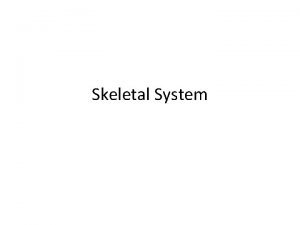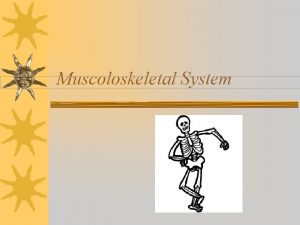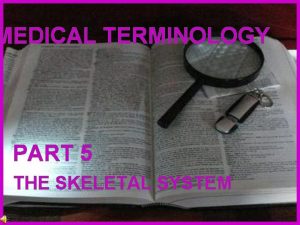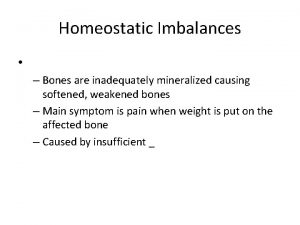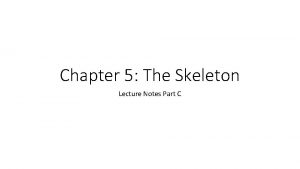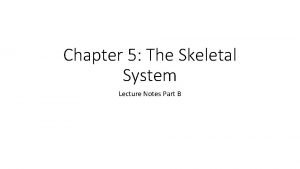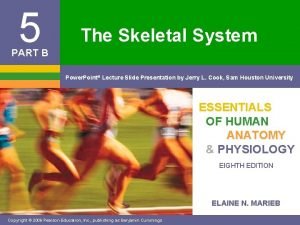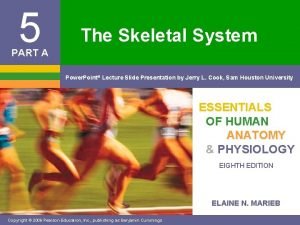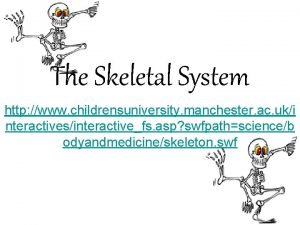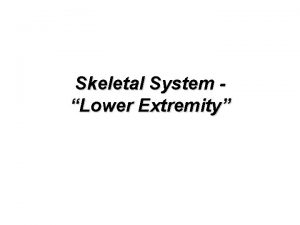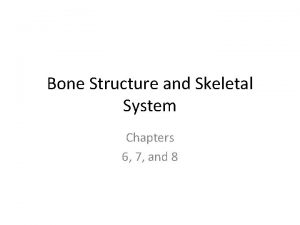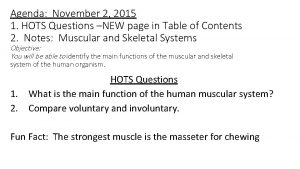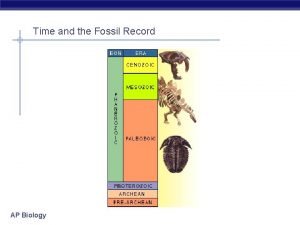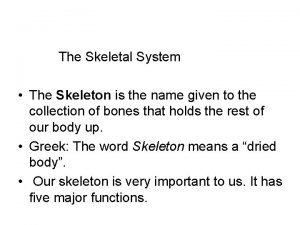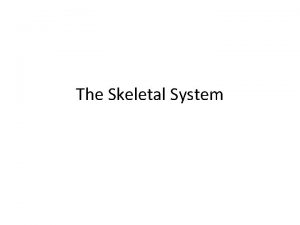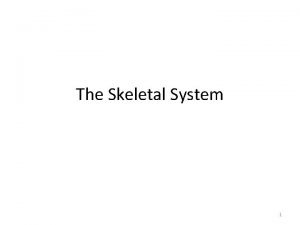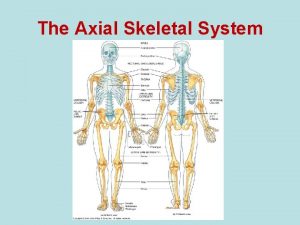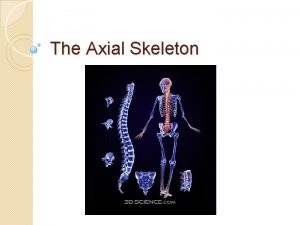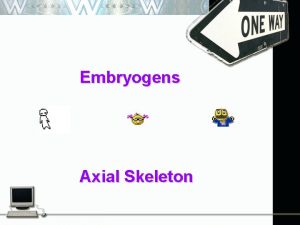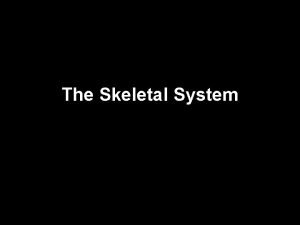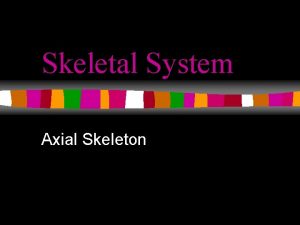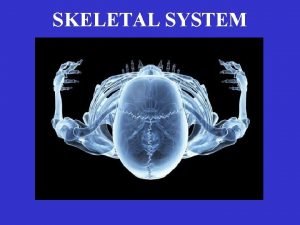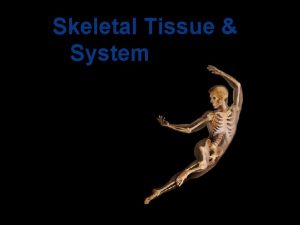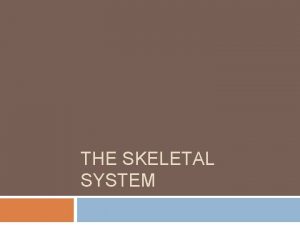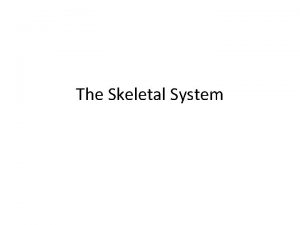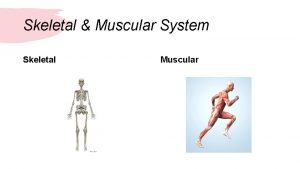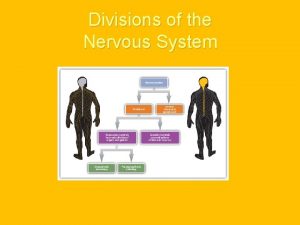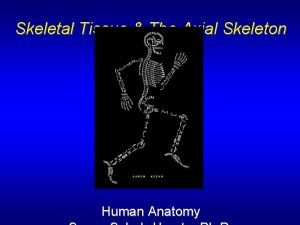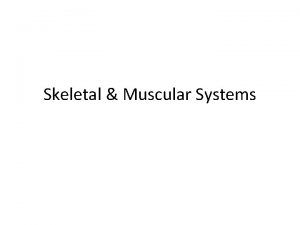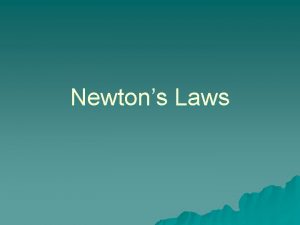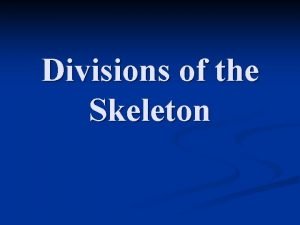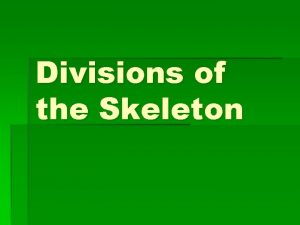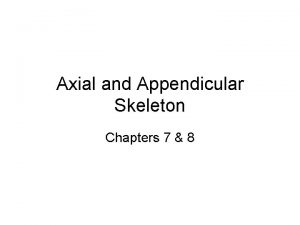The Axial Skeletal System Divisions of the Skeletal




































































































- Slides: 100

The Axial Skeletal System

Divisions of the Skeletal System • Humans are born with approximately 300 bones which fuse to 206 bones as adults. • There are 2 main divisions of the skeletal system: axial skeleton and appendicular skeleton.

Divisions of the Skeletal System • Axial skeleton forms the vertical axis of the body. • 80 bones= skull (22), vertebral column (26), ribcage (25), auditory ossicles (6), and hyoid (1) • Appendicular skeleton forms the arms, legs and the girdles • Girdles attach the arms and legs to the axial skeleton • 126 bones= pectoral girdle (4), arms (60), legs (60) and pelvic girdle (2)

Skull • Superior end of the vertebral column • Composed of flat and irregular shaped bones • Large hollow space within the skull is called the cranial vault or cranial cavity. • Functions to: – Surround and protect the brain – Be points of attachment for the facial muscles (landmarks)

Divisions of the Skull • Cranial division consists of 8 flat bones that form a protective box around the brain. – Help to form the cranial vault (cavity) – Frontal (1): forms the anterior portion of the cranial cavity • Forms the superior orbits of the eyes and forms the forehead

Frontal Bone Landmarks • Supraorbital margin: a thickened ridge of bone found superior to the orbit of the eye. – Just deep to the eyebrow and more prominent on the lateral portion – Point for muscle attachment (PFMA) • Supraorbital foramen: a small opening found on the medial aspect of the supraorbital margin. – Can feel it best inferior to the margin – Allows blood vessels and nerves to enter the frontal bone

Frontal Bone Landmarks • Frontal sinus: A hollow space found within the frontal bone, superior and medial to the supraorbital margin. – Can only be seen with a sagittal cut – ¼ inch superior to the eyebrows – House mucus and macrophages for trapping and destroying foreign particles.

Frontal Bone Landmarks • Frontal sinus: A hollow space found within the frontal bone, superior and medial to the supraorbital margin. – Can only be seen with a sagittal cut – ¼ inch superior to the eyebrows – House mucus and macrophages for trapping and destroying foreign particles.








Parietal Bones (2) • Form the lateral walls and the superior portion of the cranium. • Landmarks: – Temporal fossa: A large, shallow depression that begins on the parietal bone and extends to the frontal bone. • PFMA

Temporal Bones (2) • Form the inferior lateral walls and a portion of the floor of the cranium. • Articulate with the mandible (lower jaw) to form the temporomandibular joint (TMJ) • Temporal bone landmarks: – Mastoid process: A large, blunt projection found posterior to the external auditory meatus. • Bump behind the ear • PFMA

Temporal Bone Landmarks cont. . – Styloid process: A thin, sharp projection found inferior and medial to the external auditory meatus. • Covered with muscle so it is more difficult to identify • PFMA – Zygomatic process: A thin, flat projection found anterior to the external auditory meatus. • PFMA – External auditory meatus: The external ear canal • Opening through which the auditory nerve runs.

Temporal Bone Landmarks cont. . – Mandibular fossa: A shallow depression found inferior and slightly anterior to the external auditory meatus • This forms an articulation with the mandible • Easy to see inferiorly if the mandible is removed

Occipital Bone (1) • Forms the posterior wall and the floor of the cranium. – The spinal cord passes through this as it exits the cranial vault. • Occipital bone landmarks: – External occipital protuberance: A prominent midline projection found on the superior surface. • Where the occipital bone turns to form the horizontal part.

Occipital Bone Landmarks cont. . – Superior nuchal line: Two curved ridges that extend laterally from the external occipital protuberance. • PFMA – Inferior nuchal line: Two curved ridges that extend laterally from the external occipital protuberance, inferior to the superior nuchal line. • PFMA – Foramen magnum: A large opening in the inferior surface of the occipital bone that allows the spinal cord to exit the cranial cavity. • Largest foramen in the body.

Occipital Bone Landmarks cont. . – Occipital condyles: Paired oval-shaped projections found lateral to the foramen magnum. • Form an articulation with the 1 st bone of the spine (atlas)


Sphenoid Bone (1) • Forms the anterior floor of the cranial cavity. – Also forms a portion of the lateral walls of the cranial cavity. – Forms the posterior wall of the orbits of the eyes. – The keystone bone for the cranium because it articulates with all other cranial bones. – Shape resembles a bat with outstretched wings when viewed superiorly.

Sphenoid Bone Landmarks • Greater wing: The larger, inferior projection of the sphenoid that forms a portion of the floor and the lateral walls of the cranium. • Also forms the posterior wall of the orbits of the eyes. • Lesser wing: The smaller, superior projection of the sphenoid bone located posterior to the frontal bone.

Sphenoid Bone Landmarks cont. . • Sella turcica: A small, saddle-like depression found between the greater and lesser wings that surrounds and protects the pituitary gland. • Pituitary is an important endocrine gland • 3 parts to the sella turcica: – Tuberculum sellae: The anterior portion of the sella turcica. • Closest to the lesser wing.

Sphenoid Bone Landmarks cont. . • 3 parts to the sella turcica continued: – Hypophyseal fossa: The seat of the saddle. • Where the pituitary gland resides – Dorsum sellae: The posterior portion of the sella turcica. • Closer to the greater wing






Ethmoid Bone (1) • The small bone located anterior to the sphenoid bone in the middle of the frontal bone. – Forms a small portion of the anterior floor of the cranium. – Also forms a small portion of the medial wall of the eye orbits. – Also forms the superior portion of the nasal septum.

Ethmoid Bone Landmarks • Cribriform plate: Paired projections found lateral to the crista galli. – Has small openings called the olfactory foramina. • Olfactory foramina: A series of small openings found within the cribriform plate that allow nerves from the olfactory epithelium to pass directly into the brain. – These nerves give us our sense of smell.

Ethmoid Bone Landmarks cont. . • Crista galli: A small triangular projection found in the center of the ethmoid bone. – Near the front of the cranial cavity. – Point of attachment for the meninges (protective coverings of the brain). • Perpendicular plate: A small vertical projection arising from the inferior surface of the ethmoid bone. – Forms the superior portion of the nasal septum. – Articulates with the vomer (facial bone).

Ethmoid Bone Landmarks cont. . • Superior and middle nasal conchae: Two thin, scroll-shaped projections found lateral to the perpendicular plate – The middle nasal conchae is inferior to the superior nasal conchae. – These increase surface area of the nasal passageways • Ethmoidal cells: Air spaces found within the lateral masses of the ethmoid bone. – Small sinuses






Sutures • Fibrous joints found between the bones of the cranium. • There are 4 major sutures: – Coronal: unites the frontal bone and both parietal bones – Sagittal: unites the two parietal bones on the superior midline of the skull – Lambdoid: unites the two parietal bones to the occipital bone. – Squamous (2): unite the parietal and temporal bones on the lateral sides of the skull




The Facial Division • A group of 14 irregular bones that serves as points of attachment for muscles of the face. • Nasal (2): form the bridge of the nose. – Rectangular shaped bones – PFMA • Maxillae (2): Form the upper jaw. – Articulate with every face bone except the lower jaw. – Form part of the floors of the orbits, lateral walls and floor of the nasal cavity, and most of the hard palate (bony roof of the mouth).

Maxillary Landmarks • Infraorbital foramen: Small openings found inferior to the orbits of the eyes. – Allows passage of blood vessels and nerves. • Palatine process: a lateral projection that forms one half of the anterior portion of the hard palate. – Typically the 2 processes unite during weeks 10 -12 of embryo development. If not, cleft palate will result. This negatively impacts speech and swallowing.

Maxillary Landmarks cont… • Maxillary sinuses: a series of small spaces within the maxillae. – Empty into the nasal cavity.




Zygomatic Bone (2) • Form the prominence of the cheeks. – Also form part of the lateral wall and floor of each orbit. – Articulate with the frontal, maxilla, sphenoid and temporal bones. Zygomatic bone landmarks: • Temporal process: a thin, flat projection arising from the lateral, posterior surface of the zygomatic bone. • Articulates with the zygomatic process of the temporal bone.

Zygomatic Bone Landmarks cont. . • Zygomatic arch: created by the articulation of the temporal process of the zygomatic bone and the zygomatic process of the temporal bone.


Lacrimal Bones (2) • The smallest bones of the facial division. – Resemble the shape and size of a fingernail – Posterior and lateral to the nasal bones and form part of the medial wall of each orbit. Lacrimal bone landmark: • Lacrimal fossa: a small vertical groove formed with the maxilla, that helps drain fluid away from the eye. • Houses a lacrimal sac that gathers tears and passes them into the nasal cavity.



• Palatine Bones (2): “L” shaped bones that form the posterior portion of the hard palate. – The parts that make-up the hard palate are called horizontal plates. • Inferior Nasal Conchae (2): scroll shaped bones that form a portion of the inferior, lateral walls of the nasal cavity. – Increase surface area and help filter air along with the superior and middle nasal conchae of the ethmoid bone.





• Vomer (1): a triangular bone that forms a portion of the posterior floor of the nasal cavity. – Articulates with the perpendicular plate of the ethmoid bone to form the inferior portion of the bony nasal septum. • Mandible (1): the largest bone of the facial division. – Except for the ossicles, it is the only moveable skull bone.

Mandibular Landmarks • Mandibular body: a triangular bone that forms a portion of the posterior floor of the nasal cavity. • Ramus: the short, vertical portion of the mandible. • Angle: the area where the ramus and the body of the mandible meet. • Coronoid process: a small triangular projection found on the superior anterior portion of the ramus.

Mandibular Landmarks cont… • Condylar process: a small rounded projection found on the superior posterior portion of the ramus. • Articulates with the mandibular fossa to create the temporomandibular joint (TMJ). • Mental foramen: small openings found in the anterior surface of the body of the mandible that allow blood vessels and nerves to enter the mandible. • Alveoli: sockets for teeth


• • Auditory Ossicles The 6 smallest bones in the human body. Located medial to the eardrum. Connected by synovial joints. Function to transfer sound waves from the eardrum to the inner ear. • The bones are as follows: • Malleus- attaches to the eardrum and is commonly called the “hammer”. • Incus- middle bone that is commonly called the “anvil”. • Stapes- Smallest bone and is commonly called the “stirrup”.



Hyoid Bone • Located superior to the larynx (voice box). • U shaped • The only bone that does not articulate with another bone. • Suspends from the styloid processes by ligaments and muscles. • Often fractured during strangulation. • Functions to support the tongue.



The Vertebral Column • Also called the spine, backbone or spinal column. • Consists of 33 (children) or 26 (adults) bones called vertebrae. • Functions to protect the spinal cord, support the head, and serve as attachment points for the ribs, pelvis, back muscles and arm muscles.

Vertebrae • Vary in size, shape and detail but have many similarities. • Consist of 3 main parts: vertebral body, vertebral arch and several processes. • Vertebral body: the thickened anterior portion of a vertebra. • Holds the intervertebral disc and contains foramina for the entrance of blood vessels. • Intervertebral discs: pads of fibrocartilage that help hold the vertebrae in place. • Compress throughout the day due to weight and water loss This compression does not change height as we age.


Vertebrae continued… • Vertebral arch: located posterior to the vertebral body. • Forms the vertebral foramen with the vertebral body. • The vertebral arch consists of the pedicles and the laminae. • Pedicles: the shorter anterior portions of the vertebral arch. • Laminae: the longer posterior portions of the vertebral arch.

Vertebrae continued… • Vertebral foramen: the opening formed by the vertebral body and the vertebral arch. – Contains the spinal cord, adipose tissue, areolar connective tissue and blood vessels. • Processes: bony projections that arise from the vertebral arch. – Transverse processes: paired lateral projections that arise from the vertebral arch. – Spinous process: the single posterior projection that arises from the vertebral arch. – Both of these are PFMA



Cervical Vertebrae • The first 7 vertebrae (C 1 -C 7). • Smaller bones than other vertebrae but larger vertebral foramen. • Also have 2 transverse foramen through which the vertebral artery, vein and nerve fibers pass. • C 2 -C 6 have a branching spinous process. • C 1 is called the atlas. – Supports the skull. – It lacks a body and a spinous process.

Cervical Vertebrae cont… • C 2 is called the axis. – Has a body and a peglike process called the dens or the odontoid process. – The dens makes a pivot on which the atlas and head rotate. • C 7 is called the vertebra prominens. – Has a large spinous process that is not branched and can be felt at the back of the neck.


Thoracic Vertebrae • The next 12 vertebrae (T 1 -T 12). • Have facets (flat surfaces) where they articulate with the 12 rib pairs. • Movement of these vertebrae are most limited because the ribs attach to the sternum anteriorly.


Lumbar Vertebrae • The next 5 vertebrae (L 1 -L 5). • The largest and strongest of the bones of the spine. • Spinous processes are thick and broad.


Sacrum • The next vertebra in the adult vertebral column. • A triangular shaped bone formed from the fusion of 5 bones. This starts around age 16 and is usually completed by age 30. • Auricular surfaces: large, ear-shaped roughened surfaces found on the lateral aspect of the sacrum. – This articulates with the hip bones of the pelvis.


Coccyx • The last vertebra in the adult vertebral column. • The tailbone that is formed by the fusion of 4 vertebrae that occurs between the age of 20 -30. • In males, it points anteriorly and in females it points inferiorly.

ACT-UP

ACT-UP 1) What region of the vertebral column might be most affected by osteoporosis? 2) Why? 3) What would we expect to see (on the outside) when looking at a person suffering from osteoporosis?

Thorax • Includes the sternum, ribs and the bodies of the thoracic vertebrae. • Sternum: located along the anterior midline of the thorax. – Also known as the breastbone – Consists of 3 parts that fuse by age 25 and the points of fusion can be seen as transverse ridges. – If thoracic surgery is necessary, the sternum may be cut along the midline.

Regions of the Sternum • Manubrium: the superior portion of the sternum – Articulates with the clavicles (collarbones) and the costal cartilages of the 1 st-2 nd rib pairs. • Sternal body: the intermediate portion of the sternum. – Articulates directly or indirectly with the costal cartilages of the 2 nd-10 th rib pairs. • Xiphoid process: the inferior portion of the sternum. – Where some abdominal muscles attach.


Ribs • 12 pairs of flat bones that form a protective cage around the heart and the lungs. – Increase in length from 1 -7 and then decrease from 7 -12. – Each rib pair articulates posteriorly with its corresponding thoracic vertebra. • Costal cartilage: elongated pads of hyaline cartilage used to attach the ribs to the sternum. – Allows the ribcage to be more elastic and limits fracturing from blows to the chest.



Types of Ribs • True ribs: Rib pairs 1 -7 – Their costal cartilages attach directly to the sternum. • False ribs: Rib pairs 8 -12 – Their costal cartilages do not attach directly to the sternum. Rib pairs 8 -10 have cartilages that attach to the cartilage of 7 (which attaches to the sternum. • Floating ribs: Rib pairs 11 -12 – The costal cartilages do not attach to the sternum at all.


 Figure 6-2 structure of a typical bone
Figure 6-2 structure of a typical bone Figure 6-2 structure of a typical bone
Figure 6-2 structure of a typical bone Figure 6-4 the skeleton axial and appendicular divisions
Figure 6-4 the skeleton axial and appendicular divisions Figure 6-4 the skeleton axial and appendicular divisions
Figure 6-4 the skeleton axial and appendicular divisions Chapter 5 the skeletal system figure 5-10
Chapter 5 the skeletal system figure 5-10 Axial skeleton vs appendicular skeleton
Axial skeleton vs appendicular skeleton Receive
Receive 8 divisions of the nervous system
8 divisions of the nervous system 35-3 divisions of the nervous system
35-3 divisions of the nervous system Divisions of the nervous system
Divisions of the nervous system Section 35-3 divisions of the nervous system
Section 35-3 divisions of the nervous system Nervous system divisions
Nervous system divisions Major division
Major division Nervous system chart
Nervous system chart Part of nervous system
Part of nervous system Label the parts of the main division of the nervous system
Label the parts of the main division of the nervous system Unilever home care
Unilever home care Chapter 13 the respiratory system
Chapter 13 the respiratory system 3 divisions of comedy
3 divisions of comedy Abdominal divisions
Abdominal divisions Physiographic divisions of india
Physiographic divisions of india Oceanic zones
Oceanic zones Oceanic divisions
Oceanic divisions Number of divisions in mitosis
Number of divisions in mitosis Investment bank divisions
Investment bank divisions Cells-tissues-organ-systems-organism
Cells-tissues-organ-systems-organism Abdominal divisions
Abdominal divisions Labelled diagram of a tooth
Labelled diagram of a tooth Chapter 13 respiratory system figure 13-4
Chapter 13 respiratory system figure 13-4 Mitosis number of chromosomes in each stage
Mitosis number of chromosomes in each stage Structure of investment banks
Structure of investment banks Earth science
Earth science Nasa divisions
Nasa divisions Hosa competitive event guidelines
Hosa competitive event guidelines Division of communication
Division of communication Gut tube parts
Gut tube parts 4 divisions of geologic time
4 divisions of geologic time Indexing in milling machine head part calculation
Indexing in milling machine head part calculation Divisions of family practice
Divisions of family practice Divisions of biopsychology
Divisions of biopsychology Mitsubishi electric divisions
Mitsubishi electric divisions In simple indexing index crank movement 40/n
In simple indexing index crank movement 40/n Calibrated eyepiece graticule
Calibrated eyepiece graticule Ajk divisions
Ajk divisions Larynx extends from
Larynx extends from Filip barinka
Filip barinka Vesicouterine pouch function
Vesicouterine pouch function What are the plant divisions?
What are the plant divisions? Nyc acs divisions
Nyc acs divisions The divisions in spanish colonial society 1789
The divisions in spanish colonial society 1789 Police scotland divisions map
Police scotland divisions map Northern ireland administrative divisions
Northern ireland administrative divisions Meiosis jeopardy
Meiosis jeopardy Karma in hinduism
Karma in hinduism Acs technical divisions
Acs technical divisions What are the five functions of the skeletal system
What are the five functions of the skeletal system Medical terminology skeletal system
Medical terminology skeletal system Chapter 5 the skeletal system
Chapter 5 the skeletal system Chapter 3 skeletal system kaplan answer key
Chapter 3 skeletal system kaplan answer key Chapter 7 skeletal system
Chapter 7 skeletal system Chapter 5 the skeletal system
Chapter 5 the skeletal system Section 36-1 the skeletal system
Section 36-1 the skeletal system What are the five functions of the skeletal system?
What are the five functions of the skeletal system? Park of the body
Park of the body Dem crazy bones skeleton template
Dem crazy bones skeleton template 2009 delmar cengage learning
2009 delmar cengage learning Chapter 5 the skeletal system vertebral column
Chapter 5 the skeletal system vertebral column Chapter 32 section 2 the skeletal system answer key
Chapter 32 section 2 the skeletal system answer key Body system amusement park
Body system amusement park 5 functions of the skeleton
5 functions of the skeleton Navigating the body muscular system #3
Navigating the body muscular system #3 How to care for the skeletal system
How to care for the skeletal system Crash course skeletal system
Crash course skeletal system Whats the main function of the skeletal system
Whats the main function of the skeletal system Chapter 8 skeletal system
Chapter 8 skeletal system Chapter 7 4 skeletal system
Chapter 7 4 skeletal system Skeleton
Skeleton Chapter 5 the skeletal system figure 5-13
Chapter 5 the skeletal system figure 5-13 Skeletal system bell ringer
Skeletal system bell ringer Muscolo skeletal system
Muscolo skeletal system Burs skeletal word description
Burs skeletal word description Homeostatic imbalances of bones and joints
Homeostatic imbalances of bones and joints Typical vertebra superior view
Typical vertebra superior view Human skull superior view
Human skull superior view Chapter 5 the skeletal system
Chapter 5 the skeletal system Chapter 3 the skeletal system labeling exercises
Chapter 3 the skeletal system labeling exercises Chapter 5 the skeletal system figure 5-13
Chapter 5 the skeletal system figure 5-13 Tissue examples
Tissue examples Childrens university of manchester
Childrens university of manchester Lower extremity appendicular skeleton
Lower extremity appendicular skeleton Hyoid location
Hyoid location Somatic vs autonomic nervous system
Somatic vs autonomic nervous system Chapter 8 skeletal system
Chapter 8 skeletal system Learning objectives of skeletal system
Learning objectives of skeletal system Skeletal system
Skeletal system Hots questions on skeletal system
Hots questions on skeletal system Skeletal system
Skeletal system Skeletal system
Skeletal system Skeletal system
Skeletal system Introduction of skeletal system
Introduction of skeletal system Bone formation
Bone formation
